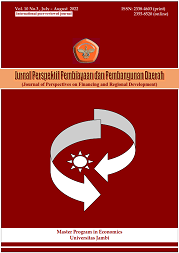Determinants of economic growth regencies/cities in Jambi Province with dynamic panel data approach
DOI:
https://doi.org/10.22437/ppd.v10i5.21136Keywords:
Dynamic panel data, Economic growth, Government expenditure, Household consumptionAbstract
This study aims to analyze the determinants of economic growth Regency/City in Jambi Province. The factors considered to be the determinants of economic growth are lagged economic growth, government expenditure, household consumption, labor, and infrastructure. This study used time series data from 2011-2020 and cross-section 11 regencies/cities in Jambi province. The analysis tool used in this study is dynamic panel data regression. The results of the dynamic panel data regression show the generalized system method of the moment model as the best model. Based on the analysis results, lagged economic growth had a significant positive effect. In the short term, labor had a significant negative effect, and infrastructure had a significant positive effect. In contrast, government expenditure and household consumption did not significantly affect economic growth. In the long run, infrastructure has a significant positive effect, while government expenditure, labor, and home consumption have no significant effect on economic growth.
Downloads
References
Abdouli, M., & Hammami, S. (2017). The Impact of FDI Inflows and Environmental Quality on Economic Growth: an Empirical Study for the MENA Countries. Journal of the Knowledge Economy, 8(1), 254–278.
Baltagi, B. H. (2005). Econometric Analysis of Panel Data (Third). England: John Wiley & Sons.
Boediono. (2009). Teori Pertumbuhan Ekonomi. Yogyakarta: BPFE UGM.
BPS. (2021a). Berita Resmi Statistik (Pertumbuhan Ekonomi Provinsi Jambi Triwulan IV 2020). Jambi: BPS Provinsi Jambi. https://jambi.bps.go.id/pressrelease/2021/02/05/498/ekonomi-provinsi-jambi-2020-terkontraksi-0-46-persen.html.
BPS. (2021b). Direktori Industri Pengolahan Besar dan Sedang Provinsi Jambi 2020. Jambi: BPS Provinsi Jambi. https://jambi.bps.go.id/publication/2021/09/09/b5e853ade7e6f3c8ea585d5d/direktori-industri-pengolahan-besar-dan-sedang-provinsi-jambi-2020.html
BPS. (2021c). Persentase Pengeluaran Per Kapita. Jambi: BPS Provinsi Jambi. https://jambi.bps.go.id/indicator/5/1619/1/persentase-pengeluaran-per-kapita-.html
BPS. (2021d). Pola Distribusi Perdagangan Provinsi Jambi 2020. Jambi: BPS Provinsi Jambi. https://jambi.bps.go.id/publication/2021/03/08/7e02ae5af820e398dc75678c/pola-distribusi-perdagangan-provinsi-jambi-2020.html.
BPS. (2021e). Provinsi Jambi Dalam Angka Tahun 2011-2021. Jambi: BPS Provinsi Jambi. https://jambi.bps.go.id/publication/2020/05/20/32c000f51fd9b52af6315cfd/provinsi-jambi-dalam-angka-2020.html.
Burlando, R., & Tartaglia, A. (2018). Physical Limits to Economic Growth : Perspectives of economic, social, and complexity science. London: Routledge. https://doi.org/https://doi.org/10.4324/9781315314969
Direktorat Jenderal Perimbangan Keuangan. (2020). Postur APBD (Pemerintah Kabupaten/Kota Provinsi Jambi Tahun 2011-2020). Jakarta: Direktorat Jenderal
Perimbangan Keuangan. https://djpk.kemenkeu.go.id/portal/data/apbd?tahun=2020&provinsi=05&pemda=-
Gujarati, D. (2012). Basic Econometrics. New York: McGraw-Hill.
Hakib, A. (2018). The Effect Of Household Consumtion and Goverment Expenditure on Economic Growth in South Sulawesi 2012-2016. BALANCE : Jurnal Ekonomi, 14(2), 281–290.
Halim, A. (2018). Teori Ekonomi Makro. Jakarta: Mitra Wacana Media.
Haniko, V. S., Engka, D. S. M., & Rorong, I. P. F. (2022). Pengaruh Konsumsi Rumah Tangga, Jumlah Ekspor dan Pengeluaran Pemerintah Terhadap Pertumbuhan Ekonomi Sulawesi Utara. Jurnal Berkala Ilmiah Efisiensi, 22(2), 110–122.
Hidayat, A. S., & Nalle, F. W. (2017). Analisis Pengaruh Belanja Pemerintah, Tenaga Kerja, Dan Pendapatan Asli Daerah Terhadap Pertumbuhan Ekonomi Regional Provinsi Jawa Timur Tahun 2010-2015. Jurnal Ekonomi Pembangunan, 15(1), 71–86.
Joshua, U. (2019). An ARDL approach to teh goverment expenditure and economic growth Nexus in Nigeria. Academic Journal of Economic Studies, 5(3), 152–160.
Juanda, B., & Junaidi. (2012). Ekonometrika Deret waktu : Teori & Aplikasi. Bogor: IPB Press.
Mankiw, N. G. (2007). Makro Ekonomi (6th ed.). Jakarta: Erlangga.
Mohmand, Y. T., Wang, A., & Saaed, A. (2016). The impact of transportation infrastructure on economic growth : empirical evidence from Pakistan. The International Journal of Transportation Research, 9(2), 63–69.
Pandusetya, D. C., Maskie, G., & Muljaningsih, S. (2021). Analysis of the Influence of Goverment Expenditure, Investment, and Labor Force On Economic Growth In Malang Regency 2000-2018. International Journal of Business, Economics and Law, 24(1), 71–78.
Petrakis, P. E. (2020). Theoretical Approaches to Economic Growth and Development : An Interdisciplinary Perspective. Athens: Palgrave Macmillan. https://doi.org/https://doi.org/10.1007/978-3-030-50068-9
Phuong, N. D., & Tuyen, L. T. M. (2018). The relationship between foreign direct investment, economic growth and environmental pollution in vietnam: An autoregressive distributed lags approach. International Journal of Energy Economics and Policy, 8(5), 138–145.
Rahman, Y. A & Chamelia, A. L. (2015). Faktor - Faktor Yang Mempengaruhi Pdrb Kabupaten / Kota Jawa Tengah Tahun 2008-2012. Jurnal Ekonomi Dan Kebijakan, 8(1), 88–99.
Rasasi, M. A., Alzahrani, Y., & Alassaf, M. (2021). On the Causal Relationship between Household Consumption and Economic Growth in Saudi Arabia. Business and Economic Research, 11(2), 165–177.
Sahoo, P., Dash, R. K., & Nataraj, G. (2010). Infrastructure Development and Economic Growth in China (Issue 261). Institue Of Development Economics, Japan External Trade Organization (JETRO).
Syamsidar, S. (2021). Analisis Pengaruh Infrastruktur terhadap Pertumbuhan Ekonomi di Provinsi Sumatera Utara. Universitas Sumatera Utara.
Syaparuddin., Zulgani., Artis, D., & Saputra, J. (2019). A study of investment pattern through economic sectors-based in Indonesia. International Journal of Innovation, Creativity and Change, 9(2), 227–240.
Tapparan, S. R. (2020). Analisis Pengaruh Pengeluaran Konsumsi Rumah Tangga Dan Pengeluaran Pemerintah Terhadap Pertumbuhan Ekonomi Tana Toraja. Journal Ekonomika Lidikti, 4(2), 12–18.
Tarigan, E. B. (2022). Pengaruh Investasi, Tenaga Kerja dan Ekspor Terhadap Pertumbuhan Ekonomi Sumatera Utara Tahun 2000-2021. Universitas Pembangunan Nasional Veteran.
Todaro, M. P., & Smith, S. C. (2012). Economics Development (11th ed.). New York: Addison-Wesley.
Widyawati, R. F. (2017). Dampak Keterbukaan Perdagangan Internasional, Modal Manusia dan Aliran Modal Terhadap Pertumbuhan Ekonomi Negara ASEAN-5 Tahun 1993-2013. Ekuilibrium : Jurnal Ilmiah Bidang Ilmu Ekonomi, 14(1), 58–70.
Yeisa, W., & Rani, L. N. (2020). Analisis Faktor-Faktor Yang Mempengaruhi Pertumbuhan Ekonomi Di Oki. Jurnal Ekonomi Syariah Teori Dan Terapan, 7(6), 1128–1145. https://doi.org/10.20473/vol7iss20206pp1128-1145
Downloads
Published
How to Cite
Issue
Section
License
Copyright (c) 2022 Hajri Puja Pratama, Syaparuddin Syaparuddin, Emilia Emilia

This work is licensed under a Creative Commons Attribution 4.0 International License.

















